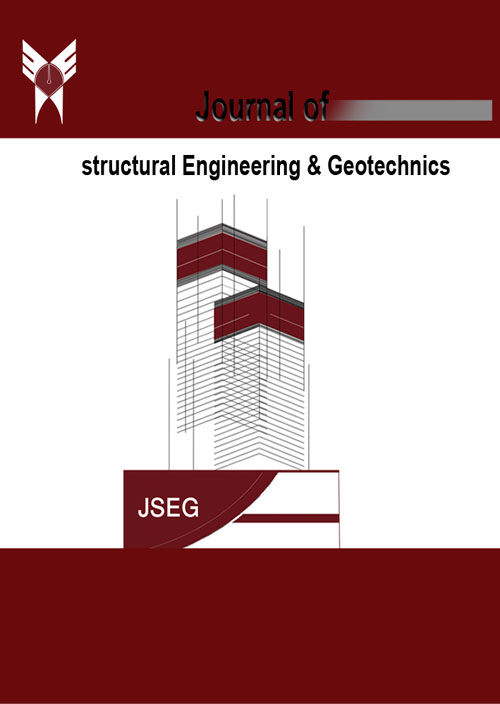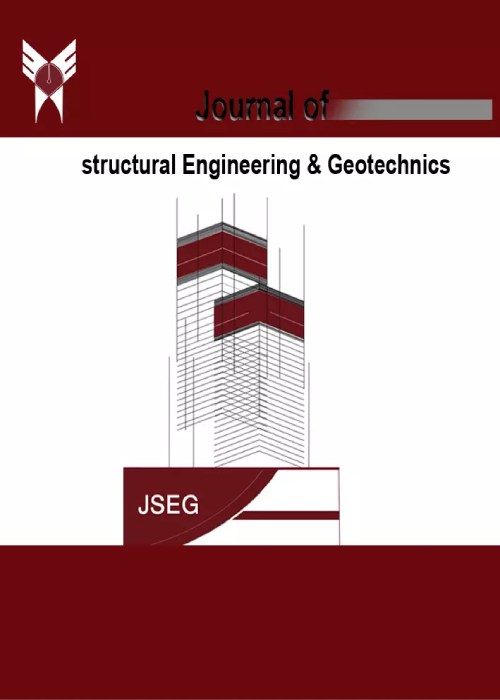فهرست مطالب

Journal of the Structural Engineering and Geotechnics
Volume:11 Issue: 1, Winter and Spring 2021
- تاریخ انتشار: 1400/05/18
- تعداد عناوین: 6
-
Pages 1-20In the recent severe earthquakes, it has been seen that existence buildings have high vulnerability. It is noticeable that the earthquakes caused extensive damage in the new constructed buildings, such as extreme structural or non-structural fractures. One of the prominent issues for the seismic design of structures is to estimate the reliability from the maximum value of structure deformations when the earthquake occurs. The main goal of this research is to determine the reliability index of serviceability limit state analysis of steel structures for their lateral deflection as the controller target function under critical excitation load. This study is very valuable for the following reasons: a) Effective quantities for the analysis and design of structures is stochastic generally and having the uncertainty. So, using the probabilistic analysis of reliability, the final result near the actual is found by influence of uncertainties. b) Applying the critical excitation earthquake for loading is so good to obtain the actual results with proper confidence margin. It is because of continuous frequency contents of such earthquakes which cause the most probable response of structure is created.Keywords: reliability index, Critical Excitation, Random Variables, Uncertainty, Power Spectral Density, Serviceability Displacement
-
Pages 21-32The purpose of this research was to evaluate the nonlinear dynamic response of rigid and semi-rigid steel frames under Far-Fault Earthquake Records. Accordingly, the fragility curve of the moment frames with rigid and semi-rigid connections was determined. Considering the analytical knowledge of structures in the past, the analysis and design of steel frames based on the assumptions of rigid or joint connections. While laboratory studies show that most connections are semi-rigid and due to the importance of connections in the structures, it is very important to recognize and accurately study their behavior, especially during an earthquake, and their design must be under their real structural behavior. For this purpose, three two-dimensional steel moment frame structures with 6, 12, and 18 stories were used, which represent short, medium, and high structures. Considering the rigid and semi-rigid connections, their seismic performance was investigated using the nonlinear dynamic incremental analysis (IDA). Three cases of connections have been selected corresponding to 50, 60, and 70% rigidity. Finally, the collapse fragility curve parameters obtained and compared. According to the obtained results, decreasing the rigidity of the beam-to-column connections increases the dispersion of the collapse fragility curve. Besides, it was observed that considering the semi-rigid connections leads to a reduction of the median of the collapse fragility curve. The result shows that the mentioned difference cannot be neglected.Keywords: Rigid, Semi-Rigid Connections, collapse fragility curve, Incremental dynamic analysis, Far-Field earthquake Records
-
Pages 33-40This paper presents the results of an experimental study on the effect of crushed sand on the properties of fresh and hardened self-compacting concrete. Mixtures of self-compacting concrete have been produced with the replacement of 0%, 25%, 50%, 75% and 100 % of natural sand with crushed sand (CSS). Same coarse aggregate with crushing percentage of 75 has been used in all mixtures. Concrete grade of 450 Kg/m3 and water to cement ratio of 0.4 have been considered in the mixture designs. Workability properties of self-compacting concrete were investigated by empirical tests viz. slump flow test, T500, V-funnel and L-box height. Rheological properties of concrete mixtures do not change remarkably by replacing 25% and 50 % of natural sand with CSS but if the mixture includes more than 50 % of CSS, the rheological properties of self-compacting concrete will be influenced negatively and may endanger the applicability of the concrete. Strength tests included cube compressive strength test, flexural strength and Splitting Tensile Strength test. The hardened self-compacting concrete exhibits excellent short term strength with 25% CSS contentKeywords: self-compacting concrete, Natural River Sand, Crushed Sand, Iranian National Standard, Strength
-
Pages 41-52One of the problematic soil types that is found in wide areas in the world is marl soils. This soil type is more sensitive to erosion and requires modifications in pavement construction processes. In this research, mixed soil-Nano-CaCo3 was considered. For this purpose, 0.3 to 2.7% Nano-CaCo3, by specific dry weight, was combined with marl soils in 0.3% increments. To analyse the geotechnical properties of marl soil, optimum water content for soil compaction, maximum dry density, uniaxial compressive strength, California Bearing Ratio (CBR) and the consolidation test were investigated. The results showed dry unit weight increases with increasing Nano-CaCo3 content up to 2.2%. Furthermore, the CBR of modified marl soil with 2% Nano-CaCo3 is 2.7 times greater than the initial CBR; it increased from 6 to 15.5 by adding up to 2% Nano-CaCo3. Moreover, adding Nano-CaCo3 to marl soil increased the uniaxial compressive stress. The optimum percentage of Nano-CaCo3 was 2%, which increased the compression strength about 1.4 times. Besides, with increasing Nano-CaCo3 up to 2.2%, the amount of void ratio decreases from 0.46 to 0.35. Additionally, the compression index Cc and swelling Index Cs are almost constant and equal to 0.09 and 0.03, respectively.Keywords: Soil Improvement, Nanomaterials, Nano-CaCo3, Marly soils, Problematic soils
-
Pages 53-64Nowadays, due to the increasing population and the expansion of urbanization, and consequently the need for high-rise and multi-storey buildings that , the safety and resistance of the load bearing members of the structures has become of interest to researchers. For this purpose, different approaches have been proposed, including nanomaterials as a suitable and optimal method. Using nanomaterials as a percentage of cement weight improves concrete performance and increases its strength. Since these materials should be used at the beginning of concrete construction, therefore, they cannot be used in constructed structures. But a protective coating containing these nanomaterials can enhance and improve the performance of the structures, which is applicable to the fabricated structures. The purpose of this study was to investigate the effect of protective coatings with Nano silica, carbon nanotube and graphene nanomaterials. For this purpose, four thicknesses different and 2% nanomaterials different, the effect of thickness and percentage of nanomaterials were investigated. The results show that the sample containing 15% of silica with 26.74 N/mm2 has the highest effect compared to other nanomaterials. However, due to the low percentages of carbon nanotube and graphene, these materials have a significant effect.Keywords: Carbon nanotubes, Micro silica, Graphene, the compressive strength of concrete, protective cover
-
Pages 65-80One of the proper methods to improve the soft and loose ground is the use of stone columns. High shear strength and low compressibility materials substituted for soft and loose soils with low shear strength and increased compressibility will transfer a significant part of the loads applied to the foundation in the soil and stone columns will improve the soil. The investigation of the previous studies has revealed that most of the numerical analyses are conducted in 2D forms by the equivalence of stone columns or a single cell. Therefore, the numerical analysis of improved soft-ground with stone columns has been investigated using the finite element PLAXIS 3D software. To this end, four layouts of stone column group were used under the foundation with various numbers of columns of 4, 9, 16 and 25. The depth of improvement was considered 6m and 10m for floating and laid on a suitable bed, respectively. The results of decreasing the percentage of a ground settlement for various groups of stone columns and improvement depths of 6m and 10m were in the ranges of 15-49% and 17-63%, respectively. Besides, the shear strain distribution and the amount of stress decreased due to the increase in the number of columns. At the end, a design diagram was presented to examine the reduction of the ground settlement in two improvement modes with an improvement depth of 6 m and 10 m compared with the unimproved ground.Keywords: Stone Column, Ground Improvement, numerical analysis, PLAXIS 3D


